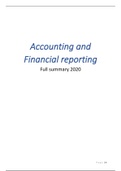Summary
Summary of Financial Accounting (first year)
- Course
- Institution
- Book
This document summarizes all the main key points of the book I used in my first year at Maastricht University. This is therefore ideal to get the key concepts of accounting and be familiar with and attain a certain level in accounting.
[Show more]





